
A PERFECT DAY
 |
Click on the collage to hear another version of A Perfect Day |
| |
| |
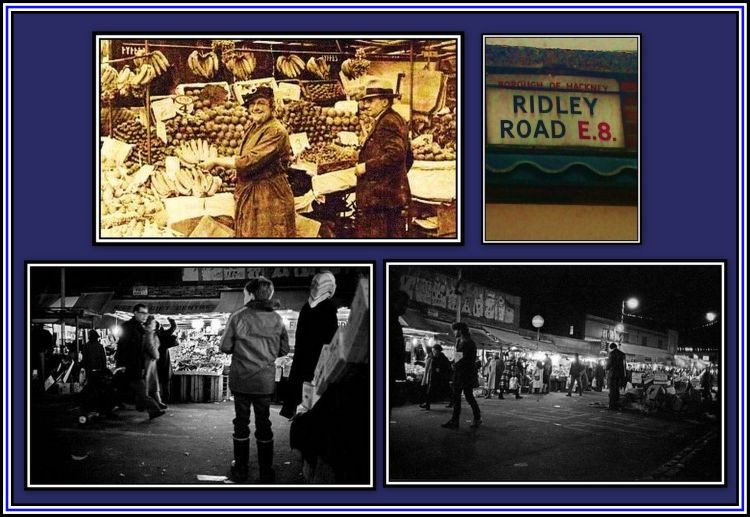 |
| |
| I was always impressed with the Ridley Road Market as the stalls were filled with exotic things to see and buy. Hackney, like Bethnal Green, has attracted numerous new immigrant populations over the years. Firstly there were Jews from Europe. Then in the 1950s, West Indians began to settle there with many still living there today. More recently, the area has seen a large Asian community move in, as well as a number from Poland and other members of the Common Market. When I was young, the area was still very Jewish, but the presence of West Indians was apparent and their presence was noticeable by what was for sale in the market. |
| |
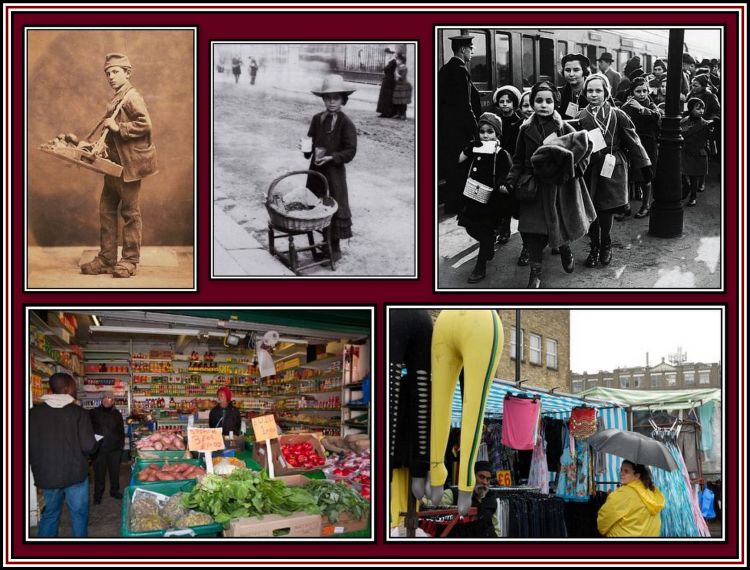 |
| |
| Ridley Road is a short street that is jammed with stalls and shops. The market has the usual vegetable and fruit stalls seen elsewhere and others where clothes and curtaining and dress material were offered for sale. Such stalls and shops offered no interest to me and luckily not to my mother since she had already made such purchases as necessary at the markets closer to home. The great thing about coming to this market was to look and to purchase delicious treats that I thought unique to the area. |
| |
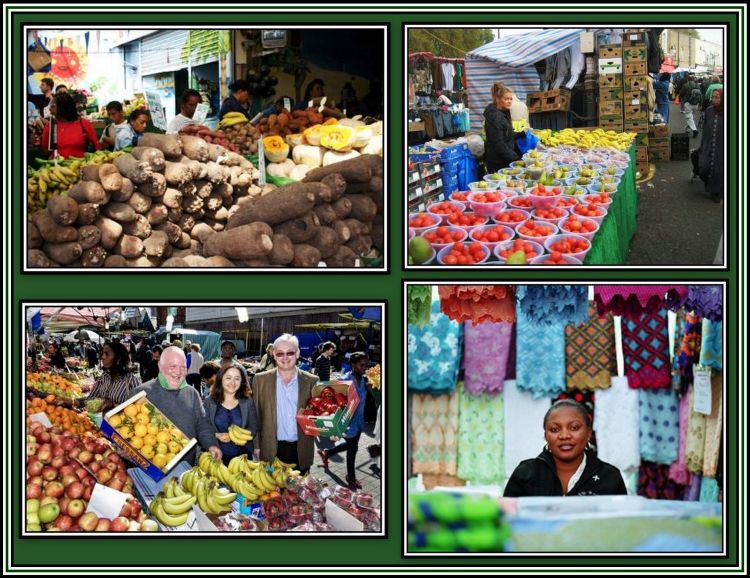 |
| |
| The market was like an Aladdin’s cave to me. I remember seeing all kinds of strange fruits and vegetables on stalls, which were mostly run by West Indians. What I liked about these fruits was that they were colourful and looked extremely appetizing. Once I went to school, I was forced to eat loathsome vegetables such as swedes, turnips and parsnips, all distinctly lacking colour and taste. |
| |
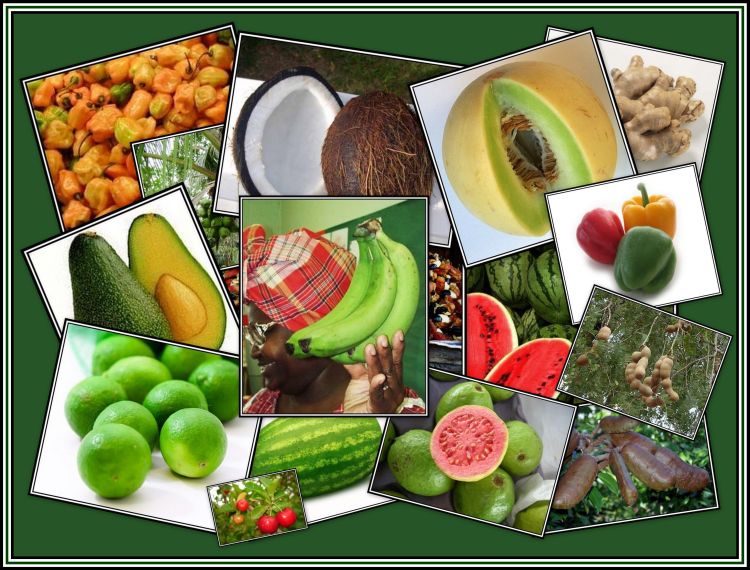 |
| |
| As nice as these fruits and vegetables were, it was the butchers’ shops that I found so fascinating. There were places where huge feet-like pieces of meat, which according to my mother were trotters, were on offer. My mother said that a trotter was a pig’s foot and she assured me that they were delicious when cooked properly. Delightful as I am sure a trotter may be, I was pleased that my mother had learned to cook from Bubbe and so certain foods were not on our menu. Upon reflection now, I feel sure that certain restricted foods were eaten without our knowledge, but I hope this was done so without appreciation. |
| |
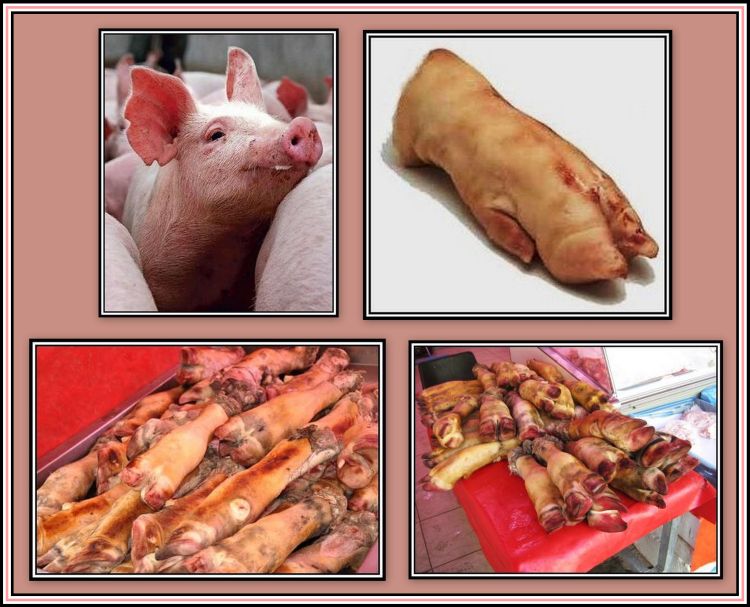 |
| |
| The poor pig seemed to be especially popular with shoppers, as each butcher’s shop displayed the head of such a poor creature in a place of prominence in its window display. I always felt that having such a trophy amongst the various cuts of meat to be totally without merit and to be extremely cruel. I had recently discovered the books of Sam Pig and could not understand why anyone would want to severe the head from such a delightful creature and put it on display. |
| |
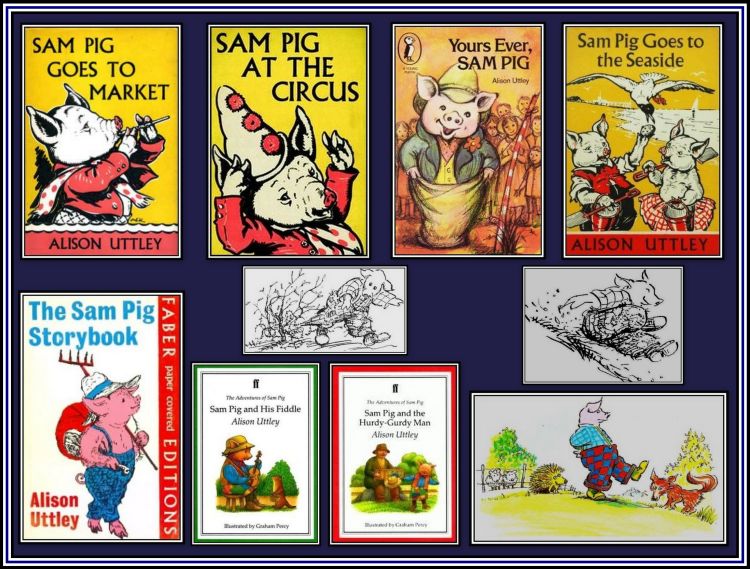 |
| |
| Other meat delicacies on offer for the discerning shopper were displayed in white enamel-coated trays for their delight. Brains, tripe and the tails of oxen overflowed their holders. Unfortunately, although I did not object to looking at these normally discarded bits of animals, I have to confess that I was never filled with a desire to taste them, although later I would find that oxtail soup can be extremely tasty. |
| |
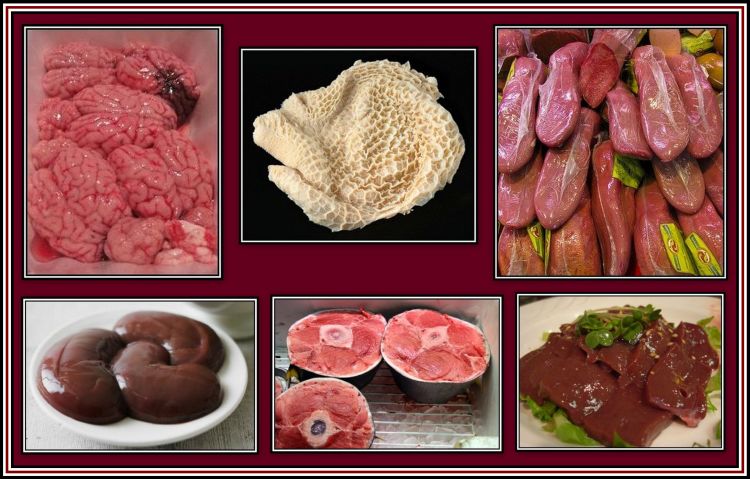 |
Delicacies
Top Row, left to right: brain, tripe & tongue
Bottom Row, left to right: kidney, oxtail & liver |
| |
| In addition to the many butcher shops in the market, there was what seemed to me to be a huge number of fishmongers. I could not understand this, as at my age, the only fish that I liked came with chips. Obviously others enjoyed fish since there was a wide variety on offer at the market, most of which I had no idea of their names. I was able to recognise haddock and cod and I knew what a kipper looked like, as my parents enjoyed them on occasion for breakfast on a Sunday morning, but the rest were unknown to me. |
| |
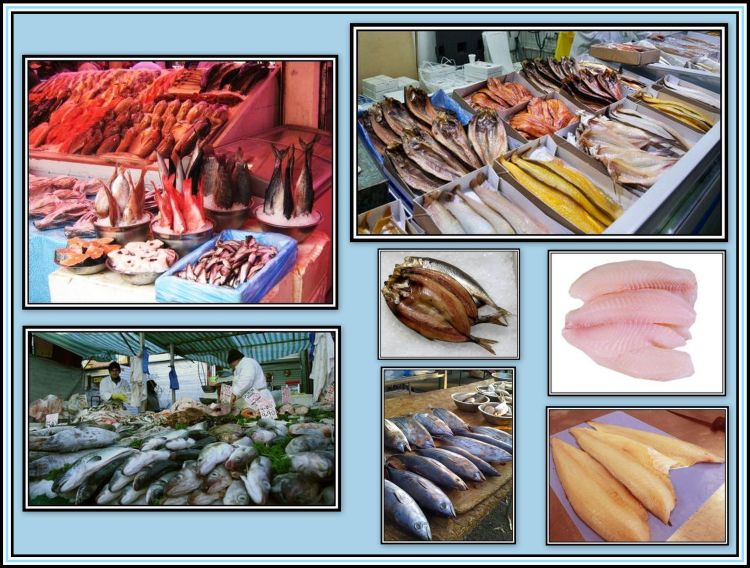 |
| A Variety of Fishes for sale including Haddock, Catfish, Herring (Kippers), Sprats etc |
| |
There was also a range of crustaceans and mollusks for sale at the market. These were more recognisable, to me as I had seen crabs and whelks at the seaside either on the shore or else being sold from the fish stalls on the sea front. The only seafood that I did not know and which I found quite unappetizing at the time was the octopus, which years later I learned was not a crustacean but a cephalopod. I remember that when my father told me that this creature had eight arms, I did not believe him. How could any creature have eight arms? Naturally my father was a lover of seafaring tales and especially liked those involving the giant beasts that once roamed the sea looking to feast on innocent creatures that were passing by. I remember that just before my going to bed, he once told me a particular gruesome tale of such a creature. Although I knew that I should not be listening to his story, I found that I could not help myself. My father was able to weave a fascinating tale that quickly mesmerized me. Later that night, the idea of a creature of the sea having eight arms proved beyond horrific for me and I awoke after a dream where I was stalked by an especially gigantic and ferocious beast with huge eyes and enormous mouth. The creature had eight long arms that stretched out and grabbed me by the ankle. As I was pulled closer and closer to that grapping mouth, another arm wrapped itself around me and I was pulled down further into the depths of the ocean. I was only able to escape the monster’s grip by waking up. Again my mother was not pleased with my father. |
| |
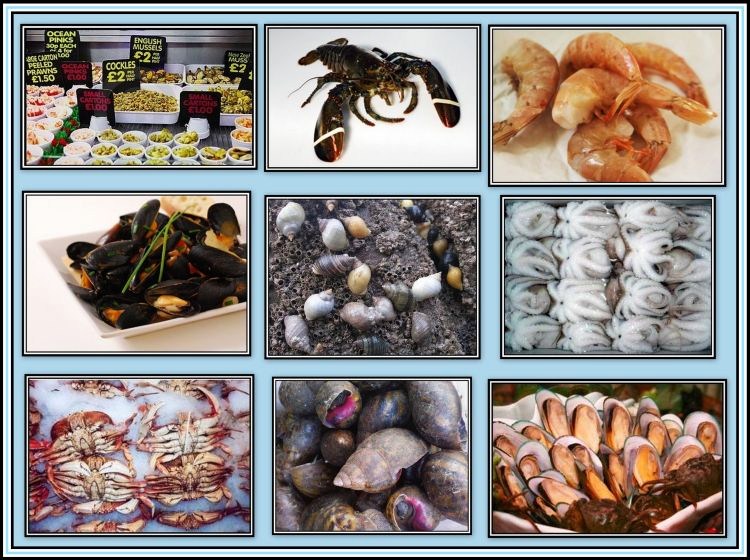 |
Seafood
Top Row: middle, lobster; right, shrimp
Middle Row: right, mussels; middle, assorted shell fish; left, octopus
Bottom Row: right, crabs; middle, whelks; left, mussels |
| |
As nice as it was to browse the stalls and shops of the Ridley Road Market, I had come to sample certain delicacies and generally could not wait to do so. I was a discerning child. I remember that whenever I was taken to the Roman Road as a very small child, whenever I was offered an ice cream or a cake as a treat, each could only be purchased from particular shops and not others. I remember that an old lady who lived next door to us took me out once one afternoon to the Roman Road shops. This poor woman went into a dither when I refused her generous offer of a cake, as it was not from my favourite baker. She was unable to appreciate that such a small child could tell the difference between an éclair prepared in one baker’s oven over that of another. Grudgingly and after some debate, she agreed to cross the street and patronize the baker of my choice. I recall that she never offered to take me shopping again.
We would purchase our delicacies at the market in a strict order. Firstly, we would visit my favourite butcher’s shop. Here my mother would purchase two Saveloy sausages, one for her and one for me. Naturally, after several visits to the shop, the butcher recognized us and always made a fuss of me. He always said that he was going to give me a special Saveloy from his store that he kept for his special customers. Of course, I believed his sales pitch. I was convinced that the Saveloys sold at this butcher’s were far more succulent and tasty than those available elsewhere. The delicacies were kept hot in a large red metal container with a design on the front. The butcher would lift me up to look inside and allowed me to choose my Saveloy from the mass of plump sausages dancing around in the brine. He used a large laden to swoop up the Saveloys and, after draining the liquid off, placed each one on a piece of greaseproof paper. Next he went to another container and, by the use of a large wooden spoon, he scooped up some Pease Pudding and placed it around each Saveloy. He next folded the paper around the delicacies, being careful to leave an opening so that bites could be easily taken, and then, he would hand the prepared feast firstly to me and then to my Mother. I would thank him and take a bite and tell him how delicious his wares were. This never failed to cause him to laugh loudly. |
| |
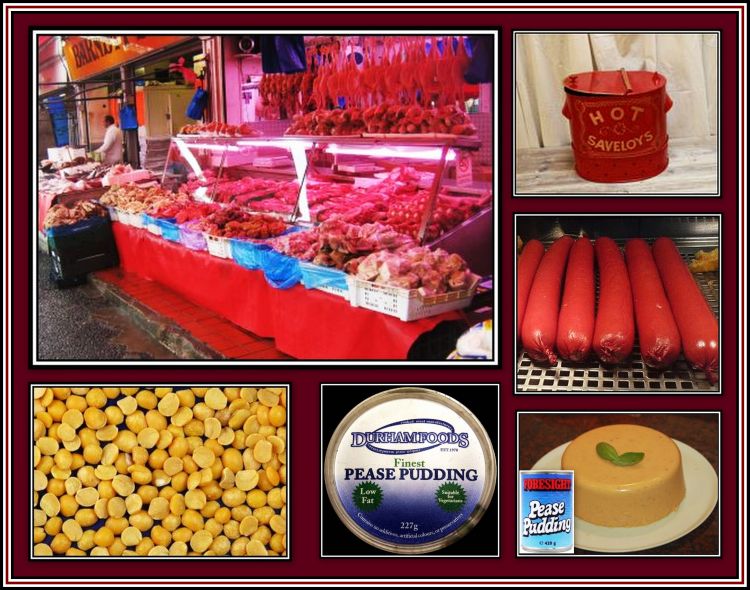 |
| |
My mouth still waters at the thought of the butcher’s Saveloy and Pease Pudding. For years I believed that the pudding was called Piece Pudding and made from crushed peas! What I found amazing about this delicacy was that it was yellow in colour and not green. To me, peas were green. I did not know that the pudding had been prepared from Chick Peas and not Garden Peas. Regardless of whether it was made from garden or chick peas, the pudding and sausage were savoured.
Once the first course of our feast was completed, we would continue our wander about the market. There was always much to see and peer at. Often there would be a Salvation Army Brass Band playing for the entertainment of the passersby. Between pieces, an Army member gave a small sermon, which I always enjoyed listening to. My mother had more than a soft spot for the Salvation Army, as she said that they had been very good to her when she was a child. After the sermon, another member would pass amongst the audience and collect the coppers that were given. I always gave them a penny, which, at that time, represented a lot of money to me, but I never regretted my donation. After this there was some hymn singing. I liked the band and especially liked the huge bass drum that was thumped to keep the rhythm. |
| |
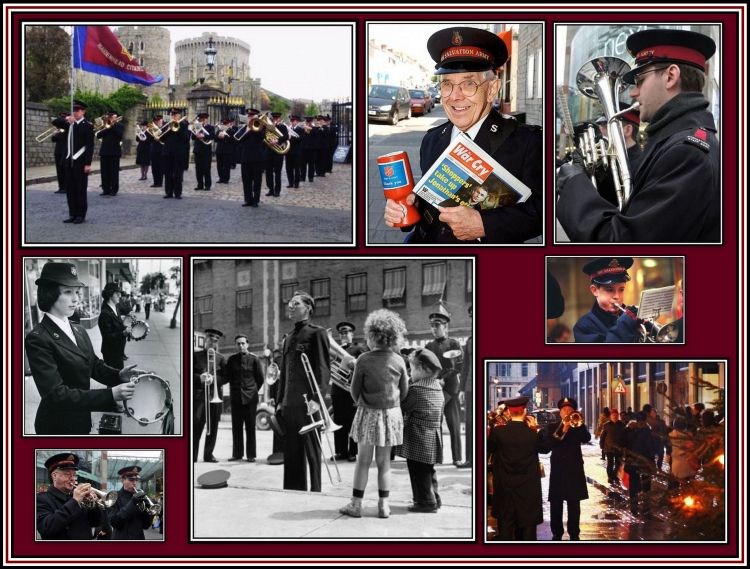 |
Salvation Army Members & Bands
Click on the pictures to hear musical clips |
| |
A little further along the market, there might be a Barrel Organ playing tunes. I remember that there used to be one particular man turning the handle of the organ who had a monkey perched on his shoulder. The animal would scamper on and off the man onto the organ while constantly raising and lowering his little hat that was held in place by a piece of black elastic under his chin. The man had a bag of peanuts and would encourage the children in the audience to offer one or two to the monkey. I would gingerly extend my hand out to the animal since I was not that trusting of the little creatures and did not want it leaping on me! As quick as a flash, the monkey would grab the peanut and would retreat back to the safety of the barrel organ top.
My mother loved the music from the barrel organ. She would tell me how she used to dance to the music whenever an organ passed down her street when she was a young girl. She loved to do this and was often given a few pennies by the organ owner, as he always collected more money whenever she performed. Whenever she was seen dancing by her stepfather, he behaved in an indignant manner and beat her for dancing in public. Despite this, he would take the coppers that she had been given and use them to buy beer. |
| |
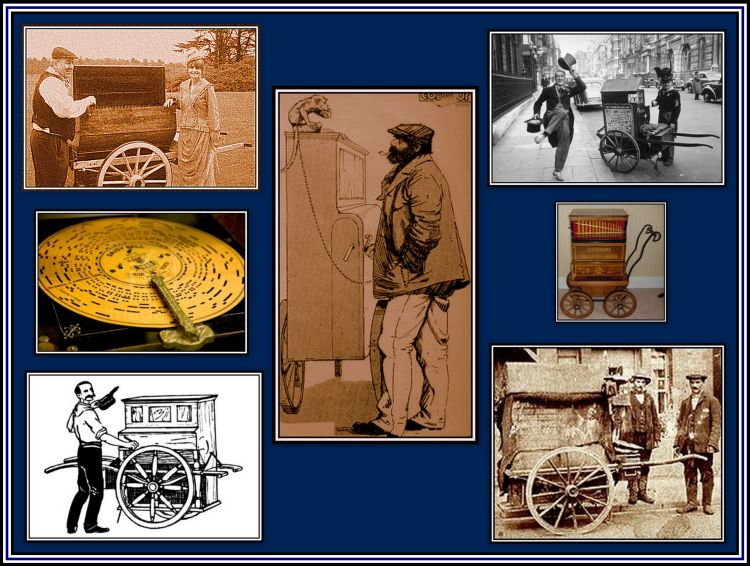 |
Click on the pictures to hear musical clips |
| |
Years later when I was living in Amsterdam, large, colourful street organs could often be seen at markets and tourist spots. I remember that during my parents’ first visit to Amsterdam, I took them to the Rijksmuseum to see the paintings of Rembrandt. As it was a nice day, once we came out of the museum, we decided to walk to the Henrikjacoobstraat Market. Suddenly, as we were walking through the small gardens in front of the museum, a large street organ began to play a rousing polka. Immediately, and without saying a word to each other, both my father and mother put
a spring in their step and began to walk in time to the rhythm of the tune being played. Their walk took them first to one side of the pavement and then back across it to the other side. As we were close to some greenery, they walked, still in time to the music, onto the grass and over to a shaded area, whereupon they began to dance. Soon they were dancing and laughing and having an enjoyable time, obviously oblivious to all around them. Once the music stopped, they calmly resumed their walk and we continued on our way to the market. This is one of my dearest memories of my parents. |
| |
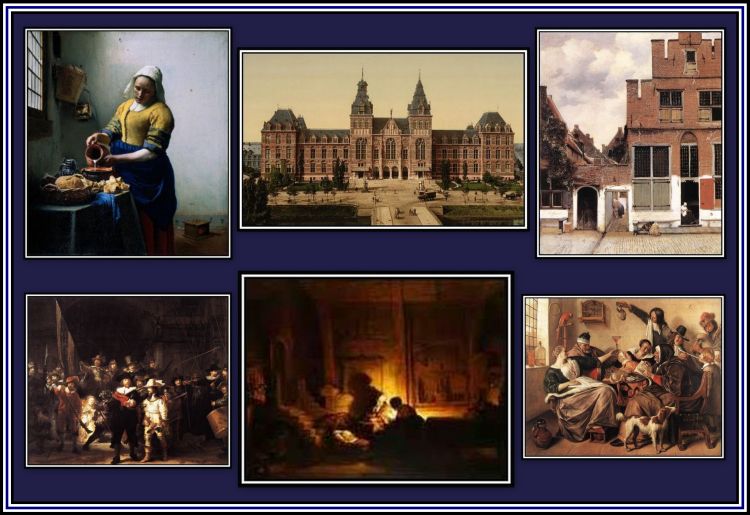 |
Rijksmuseum, Amsterdam
Top row, left to right: The Milk Maid, Johannes Vermeer; the museum; The Little Street, Johannes Vermeer
Bottom row, left to right: The Night Watch & The Holy Family, Rembrandt; The Merry Family, Jan Steen |
| |
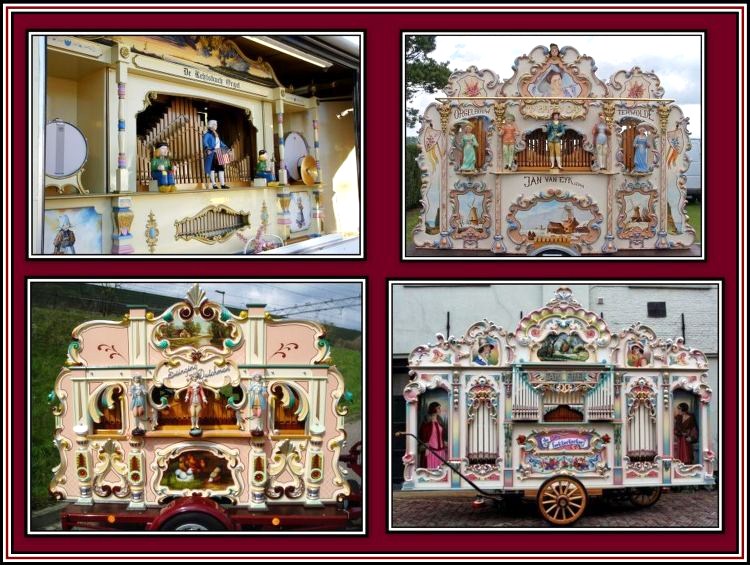 |
Dutch Street Organs
Click on the organs to hear them play |
| |
| After our musical interlude at the Ridley Road Market, it was time to sample another delicacy. My mother insisted that I made a choice as to what to feast on next. I suspect that my dislike of making a choice when it comes to food stems from this period of my life. Whenever I am faced with the dilemma of choice between small things, I refuse and become self-indulgent and take both. My mother would not allow this and would accuse me of being greedy, which of course I was. I would be given the choice between a bag of chips and a bagel. It was either one or the other. This never pleased me. |
| |
 |
| |
| I knew that my mother would be buying bagels for us to take home to eat later. And so, I choose a bag of chips. Naturally, I had my favourite fish ‘n’ chip shop, which we had to go to. I liked this one particular shop since the man fried his chips until that were a deep dark golden brown and so were much more crisp than those of other shops. I always ate my chips with a generous helping of vinegar and salt. I was horrified recently on a visit to England when I saw a mother putting Ketchup on her child’s chips. Now Ketchup is fine if you wish to eat those spindlier little sticks that are sold in fast-food restaurants now seemingly present everywhere around the world, but chips, real chips, need vinegar and a dash of salt to bring out their full flavour. |
| |
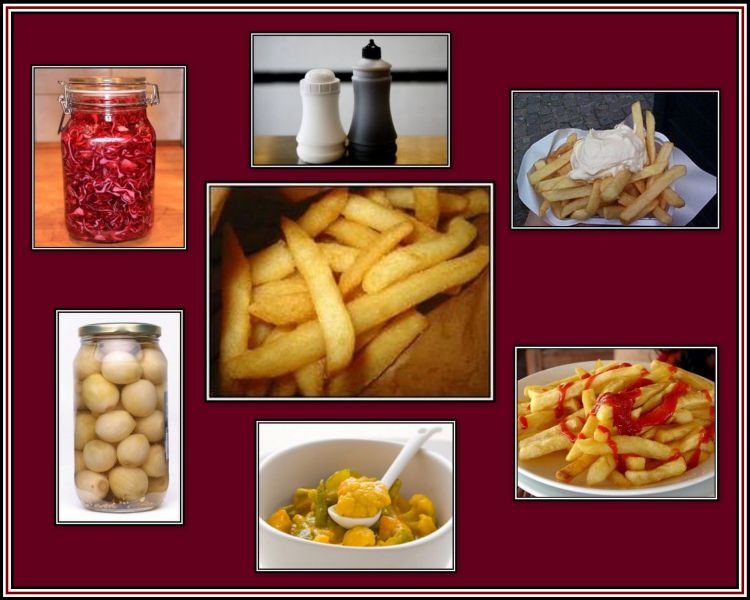 |
Possible foods to add to Chips
Salt & Vinegar, Mayonnaise, Ketchup, Piccalilli, Pickled Onions & Pickled Red Cabbage |
| |
In those days, chips were shoveled onto greaseproof paper and wrapped in newspaper. Chips never tasted better than when they were wrapped in this manner and eaten in the open air. Sadly, I fear that Londoners have taken on seemingly more sophisticated airs of late and have turned their backs on fish and traditional chips in favour of the string-like variety and meat patties between the two halves of a soft bun. I used to savour my bag of chips, but was always able to offer my mother a chip or two. Fortunately, her appetite was not as great as mine and rarely ever took more than one. Now, my father, who claimed never to eat much, always helped himself to great handfuls from my bag whenever he was offered a chip or two, much to my displeasure. I could never understand why he never got his own chips and left mine to me!
I loved the bagel shop on Ridley Road. The baker did not only offer delicious bagels for sale, but also wonderful crusty breads and the most spectacular birthday and wedding cakes. In fact, there was a card high above the counter that stated that they would prepare a cake for any occasion upon request. In addition, the displace cases were filled with the most succulent looking pastries and cakes that were a temptation to anyone. |
| |
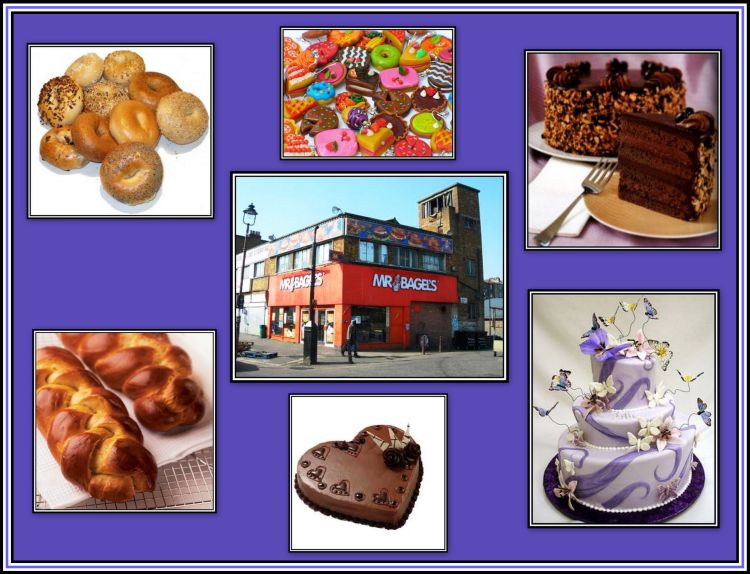 |
The Site of the Old Bagel Shop |
| |
At that time, bagels were simple little rolls with sesame seeds on top. Small, they might have been, but tasty they certainly were. Today, bagels in London have been influenced by those baked by New York bakers and a vast variety is now offered for sale in the fancy bakers that have sprung up in gentrified areas around London. Also, today’s bagel, like its American cousin, is huge compared to those sold when I was a child.
I have always loved bread and bakeries. The perfume from baking bread is hypnotic and this bakery produced a most intoxicating variety. My mother would join the line and make her purchase, which were supposedly to be eaten at home. I noticed that she always bought a couple of extras, which I was especially pleased to see, as I knew why this was done. Such a purchase always put an additional spring in my step. |
| |
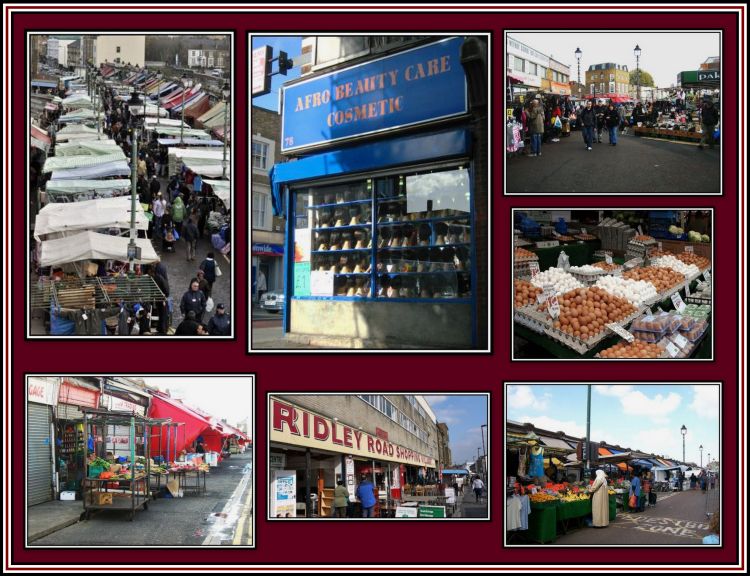 |
| |
| After this, we would spend some time looking through the remaining stalls of Ridley Road before turning into Kingsland Road. Kingsland Road is an old road and is a major artery out of London. Just across the road from its junction with Ridley Road was a good pie ‘n’ mash shop. Once we no longer had our shop, my mother came here to buy live eels. |
| |
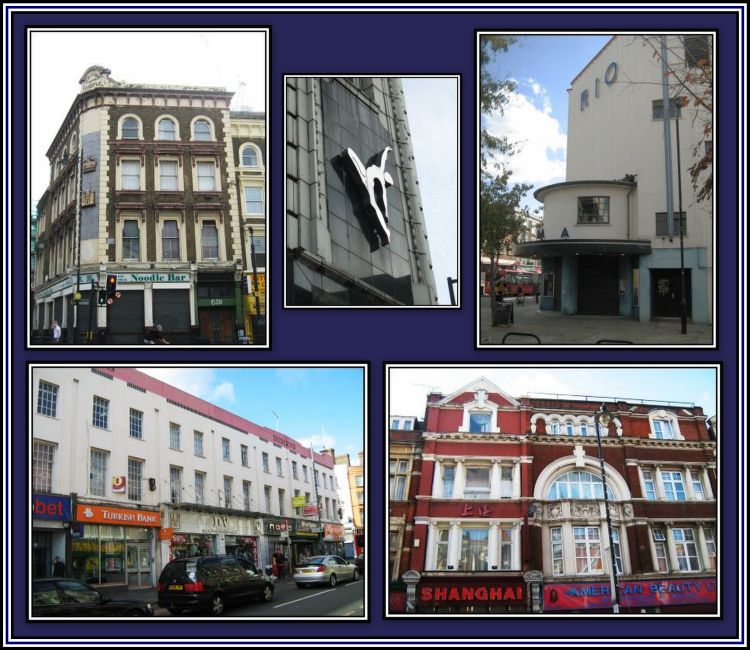 |
Kingsland High Street |
| |
| The shop was owned by F. Cooke & Sons and had been open for business for a number of years by the time I knew it. The shop was typical of such shops in that the inside was decorated with beautiful tiles and murals with a fish theme. The shop was on a design similar to ours. There was a high counter with a marble top behind which were a number of mirrors. Seating was a series of wooden forms alongside tables also with marble tops. The walls were of large mirrors with decorative tiles between. The floor was covered with sawdust, which was traditional and would be swept clean after each morning session and fresh material would be scattered prior to opening for the evening session. |
| |
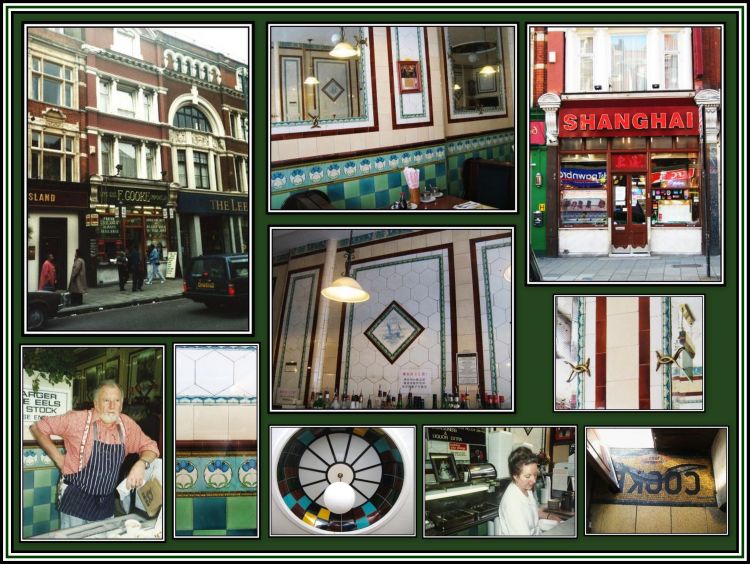 |
F. Cooke Pie 'n' Mash Shop, Kingsland Road in 1993
and is now the Shanghai Restaurant |
| |
| The shop not only sold pies, mashed potatoes and the odious parsley gravy or liquor, as well as hot and jellied eels, but also live eels for customers to buy and cook at home. Live eels were sold through an open window at the front of the shop. Customers for live eels lined up outside the shop and made their purchases through the window. Before the server, small open wooden trays displayed the slow moving, slimy eels that were for sale. My mother, knowing what a good and fresh eel looked like, would choose the ones that she wanted. The server knew my mother and knew who she was and so made no complaint when she moved the eels around to find the ones that she wanted. The chosen eels were grabbed and pulled out the container and put into the brass pan of the scale. Once weighted and paid for, the eels were prepared for transport. One final point, although my mother enjoyed a pie ‘n’ mash, we never ate one here. It wasn’t until 1964, during a visit to the area, that I tasted my first pie at this establishment. It was delicious. It wasn’t as good as those of my father, but it was good nonetheless. |
| |
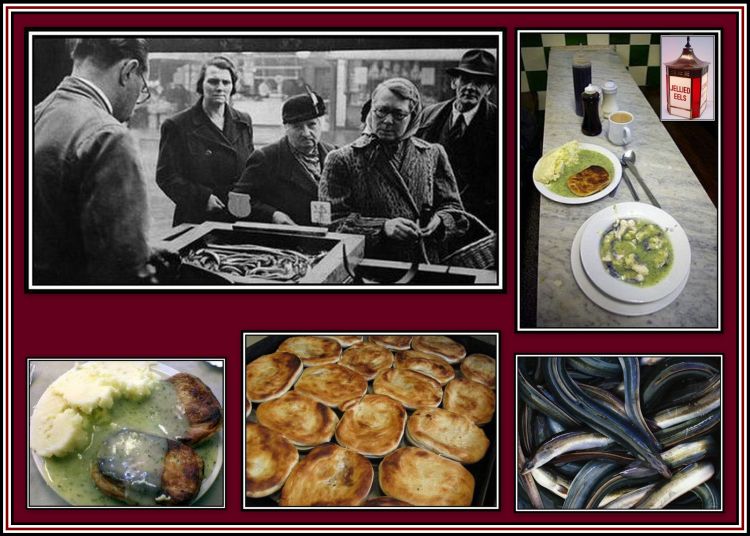 |
Pies & Eels |
| |
At this time, my father worked for British Railways and what we did next depended on his shift. If he was working days, which meant working between 6 a.m. and 2 p.m., we would have to go home so that my mother could have his lunch ready for him. However, if he was working late, which meant working from 2 p.m. until 10 p.m., we had no need to rush home and could continue with what would turn an excellent day into a perfect day. And this would mean going to the pictures. |
| |
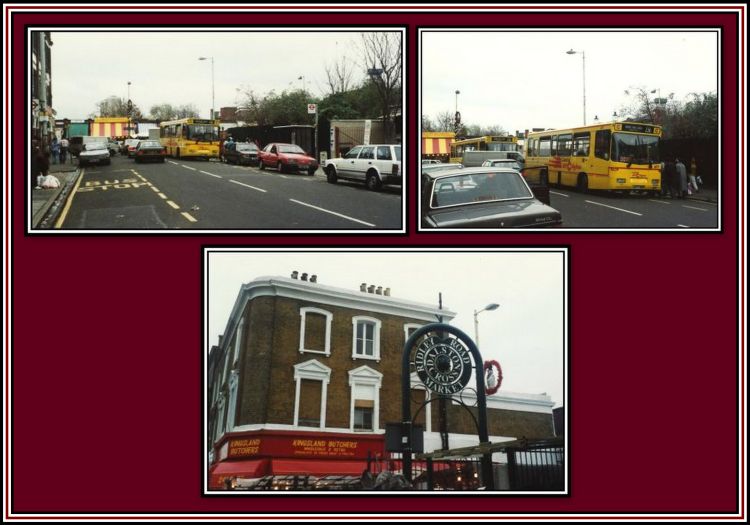 |
The Little Red Bus in Yellow Livery (made bt Volvo) at the rear entrance to the Ridley Road Market |
| |
|
|
|
|
|
|